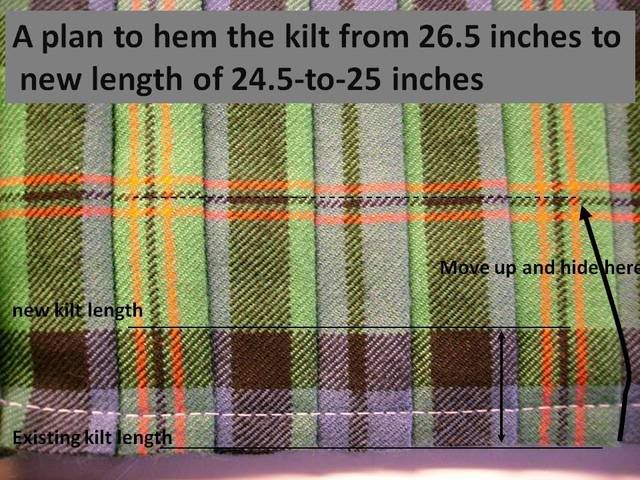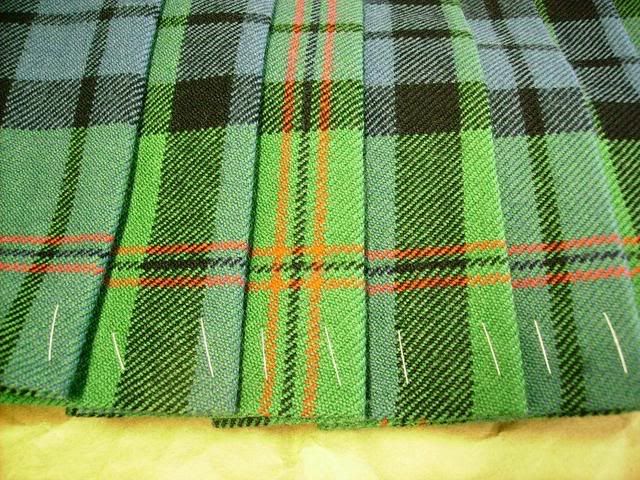|
-
21st March 10, 03:03 PM
#1
Kilt Hem Project Great Results
Last week, there was a post seeking advice on what to do with a kilt that is too long, and there was ample advice regarding the logical solution: hem it. http://www.xmarksthescot.com/forum/f...-urgent-57828/
I want to share this experience with all:
Some time ago I ordered a kilt from a major company, and due to a communications error, it was built 1.5 inches too long. As everyone knows, 1.5 inches too long is TOO LONG!
At the time I ordered the kilt, I was also having a kilt made by Bonnie Heather, a member of this forum (bonniekilts.com). So, I asked Bonnie if she could hem the kilt, and she said yes and described how she would go about doing the work.
I sent her the kilt, and this photograph describing the task as I saw it:

Notice that I emphasized hiding the stitch line into a narrow line in the tartan. I did this because Matt Newsome showed me a kilt that sombody else had hemmed, whereupon the stich line occured in such a field as to be visible- very visible indeed at some distance. I certainly wanted to hide the stitching.
Bonnie did the work, and here it is. The stitch line is confined within the dark blue line that is defined by the green/blue/orange lines that contain it.
If one cannot see the hem line at 3.5 inches, then one will never see it! Thanks Bonnie, for bailing me out.

Last edited by tyger; 22nd March 10 at 04:00 AM.
-
-
21st March 10, 03:42 PM
#2
Excellent job. I can NOT notice. She did good!!
-
-
21st March 10, 05:49 PM
#3
Bonnie did indeed do good.
But, Tyger, just because Matt had one bad hem job doesn't mean that all hem jobs will be that bad. I've hemmed my kilt made from a white-background dance tartan, not bothering to 'hide' the stitch in any kind of line and you'd be hard pressed to see any stitch at all. It's not in how you 'hide' the stitching, it's how good your stitcher is. And, obviously, you found a good'un. 
-
-
21st March 10, 08:30 PM
#4
Nicely done. And a great bit of information.
-
-
22nd March 10, 03:52 AM
#5
 Originally Posted by Dixiecat

It's not in how you 'hide' the stitching, it's how good your stitcher is. 
Thank you for emphasizing the fact that there is no substitute for excellent stitching.  I have tried a little hand sewing, and I can tell you that producing an item that I could be proud of it is just not going to happen for me. Traded thimble for torch, and never looked back. I have tried a little hand sewing, and I can tell you that producing an item that I could be proud of it is just not going to happen for me. Traded thimble for torch, and never looked back.
I don't know who hemmed the kilt that Matt showed me, all I know is that he didn't do it!
But I think I remember him telling me that the REAL problem with hemming a 16 oz kilt is that a line can appear where the 2 layers of fabric interface with the 1 layer. Thus, there is a difference in relief; therefore, a line might appear that is essentially a shadow effect. He might have said that this is not so much a problem with lighter weight fabrics. However, ususally he says so much so fast that I only catch a certain percentage of the knowledge coming my way. I will check up on this next time I go to the Scottish Tartans Museum and Gift Shop!
Last edited by tyger; 22nd March 10 at 03:58 AM.
-
-
22nd March 10, 05:15 AM
#6
 Originally Posted by Dixiecat

Bonnie did indeed do good.
But, Tyger, just because Matt had one bad hem job doesn't mean that all hem jobs will be that bad. I've hemmed my kilt made from a white-background dance tartan, not bothering to 'hide' the stitch in any kind of line and you'd be hard pressed to see any stitch at all. It's not in how you 'hide' the stitching, it's how good your stitcher is. And, obviously, you found a good'un. 
My mother once told me of how my father's mother used to hem white pillow cases with red thread just to show it could be done without any red showing. No matter how many times she saw it happen Mom was awed. No lines to hide the stitch there. I suppose the same could be done with a kilt if you know what you're doing.
-
-
22nd March 10, 06:11 AM
#7
 Originally Posted by tyger

<snip>
But I think I remember him telling me that the REAL problem with hemming a 16 oz kilt is that a line can appear where the 2 layers of fabric interface with the 1 layer. Thus, there is a difference in relief; therefore, a line might appear that is essentially a shadow effect. He might have said that this is not so much a problem with lighter weight fabrics.
 Originally Posted by Brian K

My mother once told me of how my father's mother used to hem white pillow cases with red thread just to show it could be done without any red showing. No matter how many times she saw it happen Mom was awed. No lines to hide the stitch there. I suppose the same could be done with a kilt if you know what you're doing.
I believe that hiding the thread is done by using a "blind hem stitch." The F-H.C.A.G. has a tutorial thread about hemming a SWK heavyweight that mentions that technique and my lass used it to a hem a 16oz kilt of mine. The relief line tyger mentions does show up when pressing the pleats but seems to disappear fairly quickly once worn.
- Justitia et fortitudo invincibilia sunt
- An t'arm breac dearg
-
-
22nd March 10, 08:52 AM
#8
The stitch is a herringbone stitch that catches the back of one single yarn on the back side of the kilt, then crosses over the hem turn up edge, like a zig zag, attaching there, then repeats ten million times along the length of the hem. This allows the hem to move just a little in relation to the kilt, and it is not a regular blind hem stitch. Barb T. explained it once.
I tried to ask my inner curmudgeon before posting, but he sprayed me with the garden hose…
Yes, I have squirrels in my brain…
-
-
22nd March 10, 09:13 AM
#9
It's also important to NOT press right along the turned-up edge (the selvedge, in most cases) where it hits the inside of the kilt. That pressing is what creates the relief line on the outside, making the hem most noticeable. You can press along the fold itself and right up to the edge, just don't apply the iron across that "difference in thickness" area.
If you desperately need to iron the very edge of the turned-up layer, put some thick paper or another pressing cloth along the edge so you are not pressing the outer layer of the kilt into that ditch.
IIRC Robert has explained that Lady C hemmed a tartan because she wanted the lower edge of the kilt to show a different part of the sett than the weaver had chosen. Her trained eye saw that the color at the selvedge was not the best sett element to have at the hem. Just another reason to say "yes" to hemming a kilt!
Proudly Duncan [maternal], MacDonald and MacDaniel [paternal].
-
-
22nd March 10, 09:40 AM
#10
 Originally Posted by sydnie7

IIRC Robert has explained that Lady C hemmed a tartan because she wanted the lower edge of the kilt to show a different part of the sett than the weaver had chosen. Her trained eye saw that the color at the selvedge was not the best sett element to have at the hem. Just another reason to say "yes" to hemming a kilt!
I was wondering if it was frowned upon to change the portion of the sett the kilt ends with by hemming. That was my biggest concern when I decided to have a kilt altered.
-
Similar Threads
-
By Shanntarra in forum DIY Showroom
Replies: 4
Last Post: 8th June 09, 07:40 PM
-
By AlphaKilts in forum Comments and Suggestions
Replies: 7
Last Post: 18th January 08, 07:17 PM
-
By ChromeScholar in forum How to Accessorize your Kilt
Replies: 15
Last Post: 16th January 08, 06:24 AM
-
By acstoon in forum Professional Kiltmakers Hints and Tips
Replies: 8
Last Post: 27th December 07, 07:31 PM
-
By bubba in forum General Kilt Talk
Replies: 24
Last Post: 14th February 06, 11:13 AM
Tags for this Thread
 Posting Permissions
Posting Permissions
- You may not post new threads
- You may not post replies
- You may not post attachments
- You may not edit your posts
-
Forum Rules
|
|






















Bookmarks